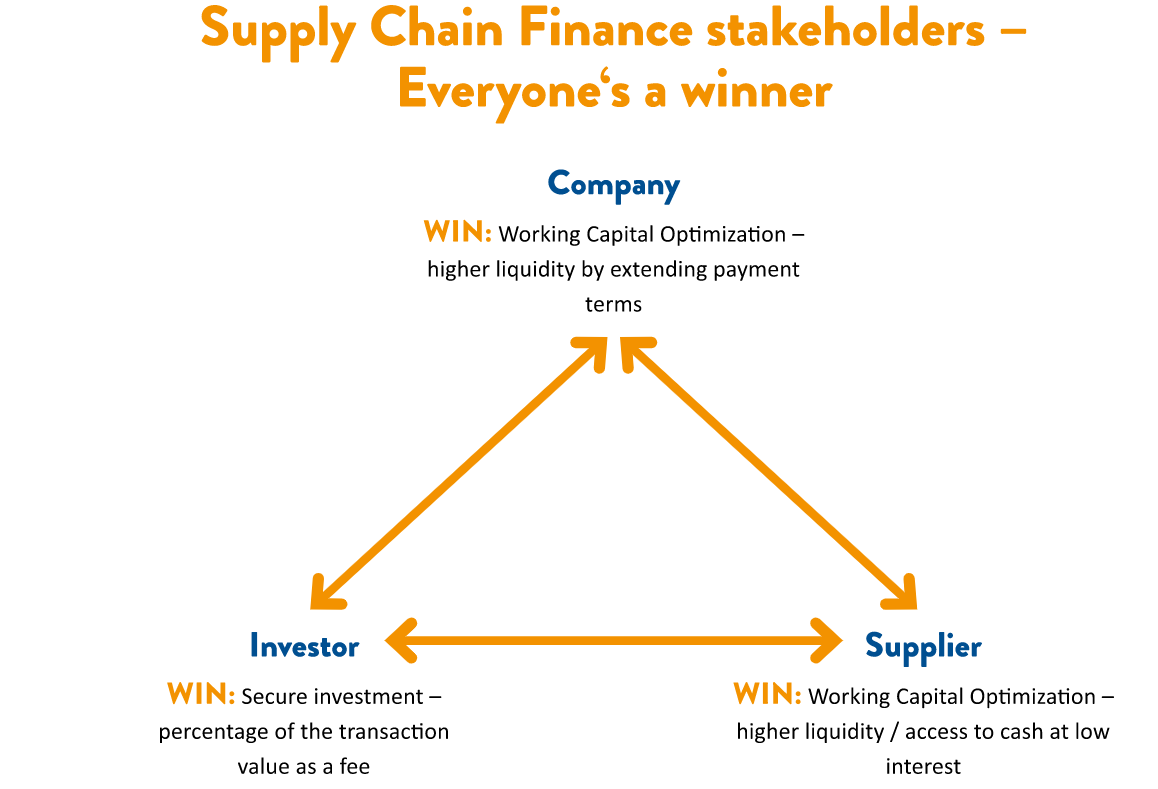Everyone is a winner with supply chain finance
These uncertain times in the global market call for flexibility. But to be able to respond flexibly, it is essential to have large cash reserves available. Companies and their suppliers are coming to a head as they both seek to optimize their working capital. So, what’s the answer? Reverse factoring.
The German car industry was once the shining beacon of the stock market, and served as a role model for many other sectors. Thanks to superior engineering skills, the big corporations enjoyed fantastic growth, high profit margins, and expansion into more and more countries. Suppliers benefitted from the knowledge of experts in their field and gained loyal partners. One company’s ideas would fuel another’s, and vice versa. There was a time when an economic crisis in the sector was unfathomable.
But just a few years later, top managers at automotive manufacturers and suppliers started to become agitated. Companies have been rocked by the diesel crisis, the trade war is stepping up in the Asian and US export industries, Brexit is creating uncertainty in the European Union, and billions of dollars are needed to invest in innovations such as electro mobility.
Now, it is all about savings, leaner processes, and liquidity. Even in sectors with well developed supply chains and firm interdependencies between manufacturers and suppliers, nothing is possible without close cooperation based on mutual trust. This is true, not least for the automotive industry at the moment, but also for practically every sector – from the chemical and consumer goods industries to mechanical engineering.
Ultimately, it is about creating high cash reserves and low stock supplies. Investing smartly can work for companies and generate returns, despite the low interest rates. Liquid reserves are also needed for procuring at the right times, such as when the price of a raw material drops in the short term, therefore reducing risk and making procurement much more flexible.
Suppliers are also striving to create the highest possible cash reserves and optimize their working capital. Since the financial crisis, it has become increasingly difficult for SMEs to obtain a loan at an interest rate they can afford, as a result of new regulations for financial institutions, such as Basel III or the upcoming Basel IV, this makes issuing capital considerably more difficult.





 The department primarily responsible for supply chain finance is, naturally, the finance department. But to ensure the process is successful, this requires cooperation with other departments, such as accounting and legal. This is what makes supply chain finance so complex within a company. The procurement department’s close involvement early on and a clear division of roles, with the support of management, are especially crucial for success. The procurement department coordinates with suppliers, while the finance department takes care of the conditions and the financial benefits. Procurement is accustomed to working in cross-departmental teams, and as a networker within the company, is able to move the subject forward. Since it is this department that has the closest relationship with suppliers, it is this department that plays a key role in the process. Reverse factoring can only work if the suppliers are closely involved too.
The department primarily responsible for supply chain finance is, naturally, the finance department. But to ensure the process is successful, this requires cooperation with other departments, such as accounting and legal. This is what makes supply chain finance so complex within a company. The procurement department’s close involvement early on and a clear division of roles, with the support of management, are especially crucial for success. The procurement department coordinates with suppliers, while the finance department takes care of the conditions and the financial benefits. Procurement is accustomed to working in cross-departmental teams, and as a networker within the company, is able to move the subject forward. Since it is this department that has the closest relationship with suppliers, it is this department that plays a key role in the process. Reverse factoring can only work if the suppliers are closely involved too. The next step is to decide which platform should be used to broker the reverse factoring. In theory, the financing could go through a single bank, but the conditions offered would not be as good as on a platform where several investors are competing against each other. When choosing the platform, it is essential to determine whether the IT system is compatible with the customer’s. Is there a seamless connection via SAP, for example? In addition, the project team should check out the platform’s references to see which banks it has as partners, what experience others have had with it, and how global the platform is. Whether the platform also works with suppliers from the USA or China is something that could be particularly relevant to global companies. Platform costs are usually negligible, and do not vary much, so this should have little bearing on the decision.
The next step is to decide which platform should be used to broker the reverse factoring. In theory, the financing could go through a single bank, but the conditions offered would not be as good as on a platform where several investors are competing against each other. When choosing the platform, it is essential to determine whether the IT system is compatible with the customer’s. Is there a seamless connection via SAP, for example? In addition, the project team should check out the platform’s references to see which banks it has as partners, what experience others have had with it, and how global the platform is. Whether the platform also works with suppliers from the USA or China is something that could be particularly relevant to global companies. Platform costs are usually negligible, and do not vary much, so this should have little bearing on the decision.  Procurement now needs to start getting in touch with suppliers. Before turning all the tried-and-tested processes on their head, it is worth first selecting a small group of suppliers to take part in a pilot. Ideally, these will be strategically important partners that have been supplying the company for a while, with whom there is already a suitable relationship of trust. Procurement must approach these suppliers systematically, and provide them with as much information as possible. A test phase is then agreed, during which both parties can familiarize themselves with the methodology and the platform, without being directly bound by an agreement. Each one of these tests initially runs as a single project, tailored to each individual supplier, and is only later summarized in an all-encompassing process. If these initial tests with suppliers are successful, additional suppliers can be contacted and incorporated. As more and more experience is gained, processes can be optimized on both sides.
Procurement now needs to start getting in touch with suppliers. Before turning all the tried-and-tested processes on their head, it is worth first selecting a small group of suppliers to take part in a pilot. Ideally, these will be strategically important partners that have been supplying the company for a while, with whom there is already a suitable relationship of trust. Procurement must approach these suppliers systematically, and provide them with as much information as possible. A test phase is then agreed, during which both parties can familiarize themselves with the methodology and the platform, without being directly bound by an agreement. Each one of these tests initially runs as a single project, tailored to each individual supplier, and is only later summarized in an all-encompassing process. If these initial tests with suppliers are successful, additional suppliers can be contacted and incorporated. As more and more experience is gained, processes can be optimized on both sides. To prevent legal or even accounting difficulties, involving the legal and financial departments is a must. The agreement needs to be based on trade accounts payable and not become a financial service, because then there is a reclassification risk. This means that the contracts have to be rewritten early on to include an extended payment term. Refinancing is then independent of the actual contract. The supplier joins the fintech platform, and is paid through that platform, but has no written guarantee that it will actually be paid any earlier. The deal and the many advantages that come with it are based on trust instead. So, it is important to involve your company’s own departments and suppliers in the planning as closely as possible.
To prevent legal or even accounting difficulties, involving the legal and financial departments is a must. The agreement needs to be based on trade accounts payable and not become a financial service, because then there is a reclassification risk. This means that the contracts have to be rewritten early on to include an extended payment term. Refinancing is then independent of the actual contract. The supplier joins the fintech platform, and is paid through that platform, but has no written guarantee that it will actually be paid any earlier. The deal and the many advantages that come with it are based on trust instead. So, it is important to involve your company’s own departments and suppliers in the planning as closely as possible. To make reverse factoring successful, it is important to clearly define the responsibilities and KPIs. Once all framework conditions have been agreed, the process is then managed by the finance department, but there must be rules on which issues involve procurement. After all, it is always the procurement department’s job to communicate with suppliers. If the first pilot projects are successful, it is up to procurement to build trust with new suppliers and convince them of the benefits of supply chain finance. Finally, feedback is routinely required from each supplier to help identify any potential for improvement in processing.
To make reverse factoring successful, it is important to clearly define the responsibilities and KPIs. Once all framework conditions have been agreed, the process is then managed by the finance department, but there must be rules on which issues involve procurement. After all, it is always the procurement department’s job to communicate with suppliers. If the first pilot projects are successful, it is up to procurement to build trust with new suppliers and convince them of the benefits of supply chain finance. Finally, feedback is routinely required from each supplier to help identify any potential for improvement in processing.







